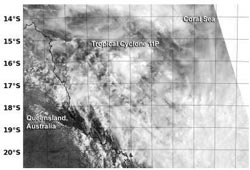

The VIIRS instrument aboard Suomi NPP captured an image of 11P on January 28 at 04:19 UTC/Jan. 27 at 11:19 p.m. EST. The image showed a more rounded circulation than the previous day, and bands of thunderstorms over the storm's southern semi-circle.
The Australian Bureau of Meteorology or ABM has issued a Cyclone Warning for coastal and island communities from Cairns to St Lawrence, including Townsville and Mackay. A Cyclone Watch remained in effect for communities through the eastern interior including Charters Towers and Moranbah. For updated warnings and watches, please visit ABM's website at: http://www.bom.gov.au
11P was passing near Willis Island, and according to the Joint Typhoon Warning Center or JTWC, the radar there indicated that the low-level center was better organized, but bands of thunderstorms appeared fragmented and loosely organized.
At 1500 UTC/10 a.m. EST on January 29, Tropical Cyclone 11P had maximum sustained winds near 35 knots/40 mph/62 kph. It was centered 247 nautical miles/284.2 miles/457.5 km east of Cairns, Australia, near 17.1 south and 149.8 east. Tropical Cyclone 11P is moving to the southwest at 6 knots/6.9 mph/11.1 kph.
The JTWC expects 11P to strengthen to 50 knots before making landfall. The JTWC forecast calls for landfall around 0000 UTC on January 31/7 p.m. EST on January 30 and the ABM forecast calls for 11P to cross the Queensland coast between Lucinda and Proserpine on January 31, Friday morning.












